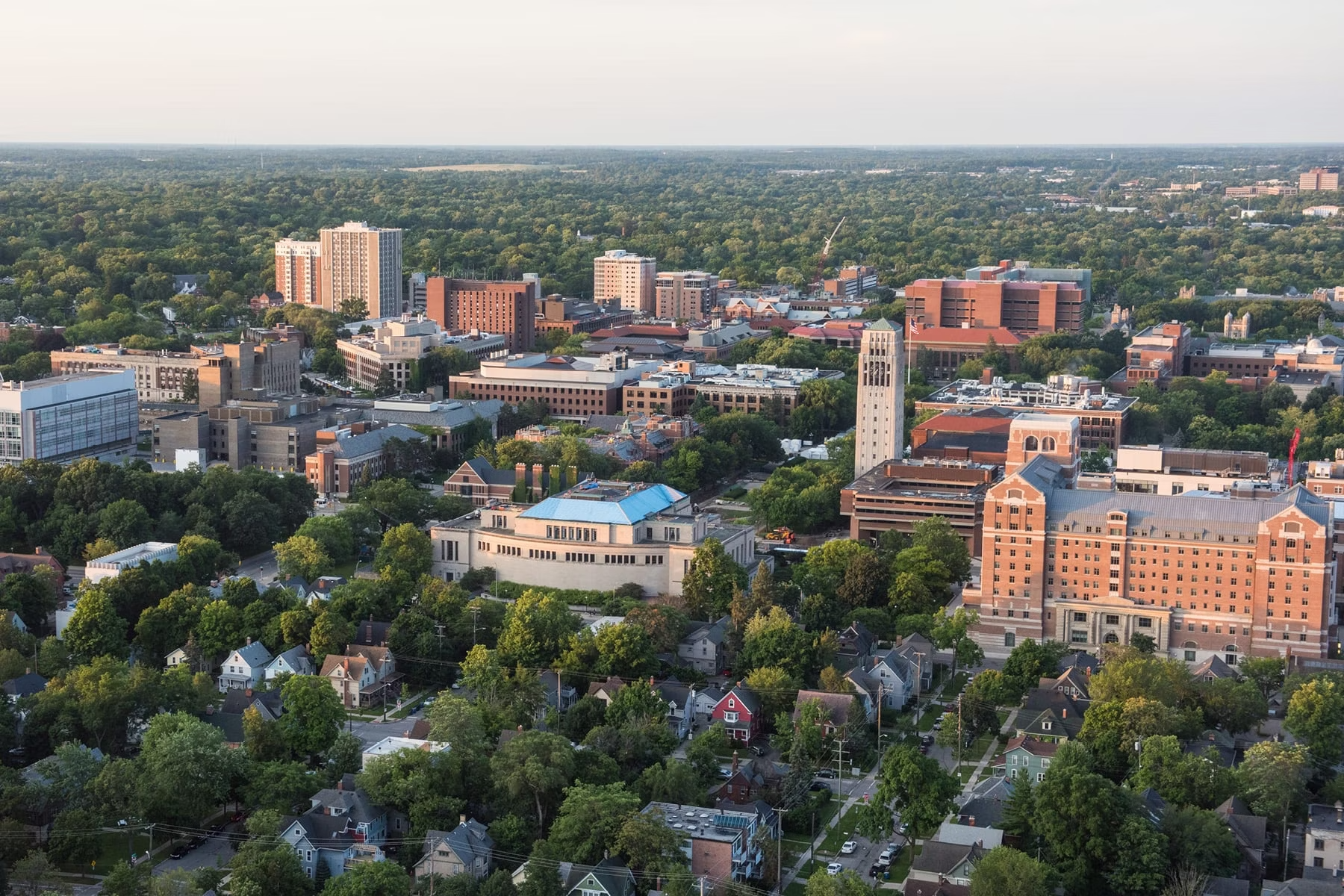University of Michigan Filing for Bankruptcy After President Trump Cuts Funding

University of Michigan's Central Campus in Ann Arbor, MI via Madonna Cristobal hide caption
ANN ARBOR, MI — In a shocking turn of events, the University of Michigan has announced that it will be filing for bankruptcy following severe budget cuts implemented by President Trumps administration. The historic institution, founded in 1817, has been struggling to keep up with financial challenges exacerbated by political tensions and ongoing campus protests.
The funding cuts come as part of a broader federal budget restructuring, which slashed allocations to public universities, particularly those that have been vocal in their criticism of government policies. The University of Michigan, known for its progressive stance and advocacy for academic freedom, found itself at the center of controversy due to ongoing student-led protests against U.S. involvement in the Israel-Palestine conflict.
Protests calling for the university to divest from companies affiliated with Israel escalated tensions between students, faculty, and donors. The administration faced mounting pressure from both pro-Palestinian activists and opposition groups, further complicating the university’s financial stability as key donors and alumni threatened to withdraw funding.
“This is a devastating blow to higher education,” said Dr. Santa Ono, current president of the university. “We have spent decades building an institution that fosters critical thinking, but without federal support, it is nearly impossible to maintain our operations at the level we once did.”
As the university prepares for bankruptcy proceedings, students and faculty are left in uncertainty about the future of their programs and research. Many have called for state intervention, urging Michigan lawmakers to provide emergency funding to keep the university afloat.
The university, which relies heavily on federal research grants and educational subsidies, has been unable to make up for the deficit. Many programs, including STEM research initiatives and financial aid for low-income students, have been slashed or completely eliminated. This will have a devastating impact on students and faculty alike, with many research projects abruptly halted due to a lack of funding. Groundbreaking work in medicine, artificial intelligence, and environmental science—once hallmarks of UM’s research excellence—has been put on hold, forcing some of the university’s top researchers to consider seeking opportunities elsewhere.
For students, the financial strain has been equally severe. Scholarships and grants that once made Michigan accessible to lower-income students have begun being revoked, forcing many to either take on additional student loan debt or consider transferring to more affordable institutions. First-generation college students, who make up a significant portion of the student body, have been particularly affected, with some being forced to not return due to an inability to afford rising tuition costs.
President Santa Ono is considering limiting the number of out-of-state students in the future to increase funding from Michigan, but does not see this as a long-term solution. Currently, out-of-state students pay significantly higher tuition than in-state students, making them a crucial source of revenue. However, state lawmakers have suggested that increasing the proportion of in-state students could help secure additional funding from the Michigan government, which has expressed concerns over the university’s reliance on federal support.
While this approach may provide short-term relief, experts warn that it could also lead to a decline in overall revenue, as out-of-state tuition fees help subsidize many of the university’s programs. Additionally, reducing the number of out-of-state students could make the university less competitive on a national scale, potentially harming its reputation as a top-tier public institution.
“It’s a delicate balance,” Ono stated. “We need to support Michigan residents, but we also have to consider the financial and academic implications of limiting out-of-state enrollment.”
University officials are weighing this option alongside other potential solutions, such as increasing private donations, restructuring academic programs, and lobbying for emergency state funding. However, with no clear resolution in sight, students and faculty remain uncertain about the future of the institution.
As a result of the financial crisis, the university has begun the process of shutting down key facilities, including several libraries, research labs, and student support centers. The iconic Michigan Union will soon close its doors indefinitely, and major campus renovations have been halted. The closures have left students distraught, especially rising seniors, who had hoped to finish their college experience with access to the same resources and traditions that defined their earlier years at Michigan.
For seniors, the uncertainty surrounding the university’s financial collapse has begun to cast a shadow over what was supposed to be a celebratory final month. Many fear that graduation ceremonies may be canceled or severely downsized due to budget constraints, robbing them of the chance to walk across the stage and celebrate their achievements with friends and family.
There are also growing concerns over whether their degrees will hold the same prestige if the university continues to decline or, in a worst-case scenario, shuts down entirely. Some students have even begun exploring transfer options, hoping to graduate from an institution with more stability. Many juniors are grappling with their own anxieties—after three years of hard work, they worry that their efforts may be in vain if the university fails to survive long enough for them to earn their diplomas. Many fear that future employers and higher education institutions will view a degree from a bankrupt university as less valuable, making it even more challenging to secure jobs or admission into competitive programs. “We put in all this work, all these late nights studying, all these sacrifices, and now there’s a real chance we won’t even get to graduate from the school we chose,” says Jenna Bates, Michigan junior pursuing a biochemical engineering degree. “It’s terrifying.” With no clear answers from the administration, students are left in limbo, watching helplessly as the institution they once took pride in crumbles around them.
University officials have stated that they are exploring options to keep certain programs running, including potential mergers with private institutions. Some discussions have reportedly taken place with schools such as Northwestern University and the University of Chicago about integrating certain research programs, while others suggest that Michigan’s Ross School of Business and College of Engineering could become semi-independent entities affiliated with private universities. However, these talks are still in their early stages, and there is no guarantee that such partnerships would preserve the integrity of the University of Michigan’s programs.
Some experts have suggested that UM may become a tuition-driven institution with reduced public funding, drastically changing the landscape of higher education in Michigan. If this were to happen, tuition costs could skyrocket, making the university unaffordable for many in-state students who rely on lower tuition and state-funded scholarships. Additionally, shifting to a more privatized model could lead to reduced financial aid opportunities, the elimination of certain less profitable programs, and an increased emphasis on attracting wealthy, full-paying students from out of state and internationally. Critics argue that such a move would erase the university’s long-standing mission of providing a world-class education to Michigan residents, fundamentally altering its role as a top public institution.
As the situation worsens, other universities have stepped in to offer UMich students alternative paths to completing their education. Schools such as Michigan State University, the University of Illinois Urbana-Champaign, the University of Wisconsin-Madison and even rival, Ohio State University, have announced extended transfer application deadlines for University of Michigan students, allowing them more time to apply for the upcoming academic year. These institutions have also stated that they will consider waiving certain application fees and expediting credit transfer evaluations to ensure a smoother transition for those looking to continue their studies elsewhere.
For many students, the prospect of transferring is bittersweet. While some are grateful for the opportunity to continue their education uninterrupted, others are heartbroken at the thought of leaving behind the community and traditions that made Ann Arbor feel like home. With no clear resolution in sight, students are left weighing their options, hoping for a solution that allows them to graduate with a degree that still carries the prestige and value they worked so hard for.
For now, the fate of one of the nation’s most prestigious public universities hangs in the balance, with students and staff bracing for the possible closure of key programs and departments.





